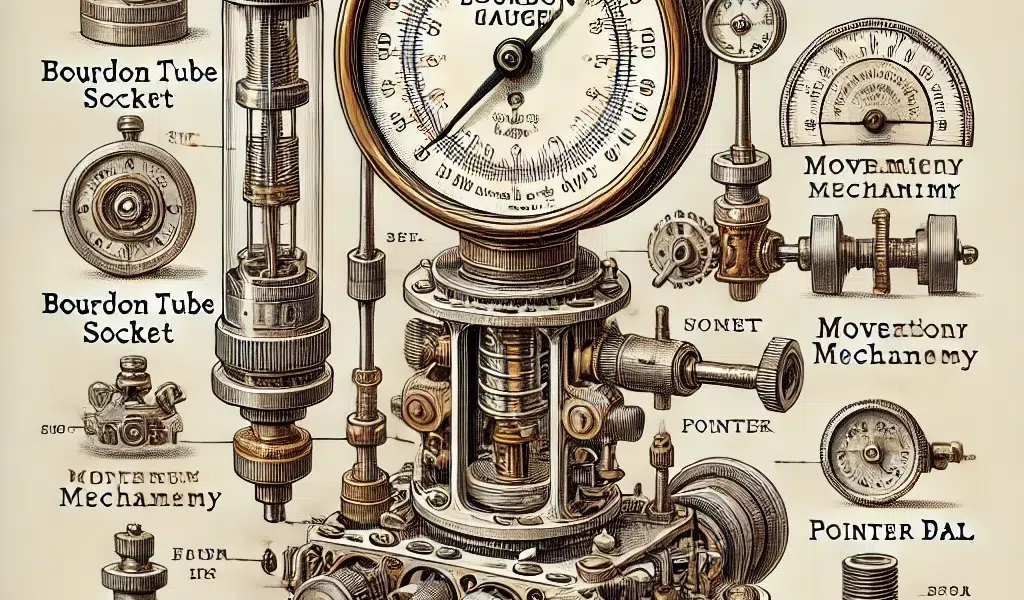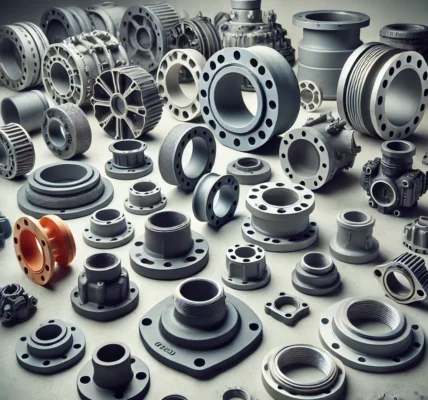The Bourdon gauge is a fundamental instrument in the field of pressure measurement, widely used across various industries due to its reliability, accuracy, and simplicity. Invented by Eugène Bourdon in 1849, this device has withstood the test of time, becoming a staple in both industrial and scientific applications. This blog will delve into the intricacies of the Bourdon gauge, exploring its design, working principles, applications, advantages, and limitations, while using the keyword “Bourdon gauge” at least five times to provide a comprehensive understanding.
The History and Invention of the Bourdon Gauge
The Bourdon gauge was invented by French engineer Eugène Bourdon in the mid-19th century. Bourdon’s invention was a breakthrough in pressure measurement technology, providing a more accurate and reliable method compared to the existing manometers and barometers. The simplicity and effectiveness of the Bourdon gauge led to its rapid adoption in various industries, cementing its place as a crucial tool for pressure measurement.
Design and Components of the Bourdon Gauge
At its core, the Bourdon gauge consists of several key components:
- Bourdon Tube: The heart of the Bourdon gauge is the Bourdon tube, a curved, hollow, and flexible tube made from materials such as brass, bronze, stainless steel, or other alloys. The shape of the tube can vary from a simple C-shape to a more complex spiral or helical form, depending on the application and desired sensitivity.
- Socket and Connector: The socket is the part of the gauge that connects to the pressure source. It is typically made from the same material as the Bourdon tube and serves as the interface between the gauge and the system whose pressure is being measured.
- Movement Mechanism: The movement mechanism translates the deformation of the Bourdon tube into a readable output. This mechanism usually consists of a series of gears, levers, and linkages that amplify the small deflection of the Bourdon tube into a larger, more easily readable motion of the pointer.
- Pointer and Dial: The pointer is attached to the movement mechanism and moves over a calibrated dial to indicate the pressure. The dial is typically marked in units such as psi (pounds per square inch), bar, or kPa (kilopascals), providing a visual representation of the measured pressure.
Working Principle of the Bourdon Gauge

The operation of the Bourdon gauge is based on the principle of elastic deformation. When pressure is applied to the Bourdon tube, it tends to straighten or uncoil, depending on its initial shape. This deformation is proportional to the applied pressure. The movement mechanism amplifies this deformation and converts it into the rotational movement of the pointer, which then indicates the pressure on the dial.
- Pressure Application: When pressure is applied to the Bourdon tube via the socket, the internal pressure causes the tube to deform.
- Elastic Deformation: The applied pressure causes the Bourdon tube to straighten out or uncoil. The amount of deformation is directly proportional to the applied pressure.
- Mechanical Amplification: The deformation of the Bourdon tube is transferred to the movement mechanism. The gears and linkages amplify the small deformation into a larger rotational motion.
- Pressure Indication: The amplified motion is transmitted to the pointer, which moves over the calibrated dial to indicate the pressure.
Types of Bourdon Gauges
Bourdon gauges come in various types, each designed for specific applications and pressure ranges:
- C-Type Bourdon Gauge: The most common type, featuring a simple C-shaped Bourdon tube. It is suitable for general-purpose applications and moderate pressure ranges.
- Spiral Bourdon Gauge: This type has a spiral-shaped Bourdon tube, providing greater sensitivity and accuracy. It is used for measuring lower pressures with high precision.
- Helical Bourdon Gauge: The helical-shaped Bourdon tube offers the highest sensitivity and is used for measuring very low pressures with extreme accuracy.
- Sealed Bourdon Gauge: This type is used for measuring absolute pressure, where the Bourdon tube is sealed and evacuated. It measures the pressure relative to a vacuum.
Applications of the Bourdon Gauge
The versatility and reliability of the Bourdon gauge make it suitable for a wide range of applications across various industries:
- Industrial Applications: Bourdon gauges are widely used in industrial settings to monitor and control process pressures in systems such as boilers, compressors, and hydraulic systems. They are essential for ensuring the safe and efficient operation of industrial equipment.
- HVAC Systems: In heating, ventilation, and air conditioning (HVAC) systems, Bourdon gauges are used to measure refrigerant pressures, ensuring the proper functioning of the system.
- Medical Equipment: Bourdon gauges are used in medical equipment such as oxygen tanks and anesthesia machines to monitor and control gas pressures.
- Automotive Industry: In the automotive industry, Bourdon gauges are used to measure tire pressures, oil pressures, and fuel pressures, ensuring the safety and performance of vehicles.
- Laboratory and Scientific Research: Bourdon gauges are used in laboratory and scientific research to measure pressures in experiments and equipment, providing accurate and reliable data.
Advantages of the Bourdon Gauge

The Bourdon gauge offers several advantages that contribute to its widespread use:
- Accuracy: The Bourdon gauge provides accurate and reliable pressure measurements, making it a trusted tool in critical applications.
- Durability: The robust construction of the Bourdon gauge ensures long-lasting performance, even in harsh environments.
- Simplicity: The simple design of the Bourdon gauge makes it easy to use, maintain, and calibrate.
- Versatility: The Bourdon gauge is available in various types and pressure ranges, making it suitable for a wide range of applications.
- Cost-Effective: The relatively low cost of the Bourdon gauge compared to other pressure measurement devices makes it an economical choice for many applications.
Limitations of the Bourdon Gauge
Despite its many advantages, the Bourdon gauge has some limitations:
- Temperature Sensitivity: The accuracy of the Bourdon gauge can be affected by temperature changes, which can cause the Bourdon tube to expand or contract.
- Vibration Sensitivity: The Bourdon gauge can be affected by vibrations, which can cause the pointer to oscillate and affect the accuracy of the measurement.
- Limited Pressure Range: While the Bourdon gauge is suitable for a wide range of pressures, it may not be suitable for extremely high or extremely low pressures.
- Mechanical Wear and Tear: The mechanical components of the Bourdon gauge can wear out over time, affecting the accuracy and reliability of the measurement.
Calibration and Maintenance of the Bourdon Gauge
Regular calibration and maintenance are essential to ensure the accuracy and reliability of the Bourdon gauge. Calibration involves comparing the readings of the Bourdon gauge with a reference standard and adjusting the gauge as necessary to ensure accuracy. Maintenance involves inspecting and cleaning the gauge, checking for signs of wear and tear, and replacing any damaged or worn components.
- Calibration: The Bourdon gauge should be calibrated periodically using a reference standard. Calibration can be performed in-house or by a certified calibration laboratory.
- Inspection and Cleaning: Regular inspection and cleaning of the Bourdon gauge are essential to ensure its proper functioning. The gauge should be inspected for signs of damage, corrosion, or wear, and cleaned to remove any dirt or debris.
- Component Replacement: Damaged or worn components should be replaced to ensure the accuracy and reliability of the Bourdon gauge. This may include replacing the Bourdon tube, movement mechanism, or pointer.
Innovations and Future Trends in Bourdon Gauge Technology

While the basic design of the Bourdon gauge has remained largely unchanged since its invention, there have been several innovations and improvements in materials, manufacturing processes, and calibration techniques that have enhanced its performance and reliability.
- Advanced Materials: The use of advanced materials such as stainless steel, titanium, and specialized alloys has improved the durability and performance of the Bourdon gauge, making it suitable for use in more demanding environments.
- Digital Displays: Modern Bourdon gauges are often equipped with digital displays, providing more precise and easily readable measurements. Digital displays also allow for the integration of additional features such as data logging and remote monitoring.
- Automated Calibration: Advances in calibration techniques have led to the development of automated calibration systems, improving the accuracy and efficiency of the calibration process.
- Smart Sensors: The integration of smart sensor technology into Bourdon gauges allows for real-time monitoring and diagnostics, providing valuable insights into the performance and condition of the gauge.

The Bourdon gauge remains a vital tool in the field of pressure measurement, offering accuracy, reliability, and simplicity. Its widespread use across various industries is a testament to its enduring value and effectiveness. While the basic design has remained unchanged since its invention by Eugène Bourdon in 1849, continuous innovations and improvements have ensured that the Bourdon gauge remains a crucial instrument in modern pressure measurement applications. By understanding the design, working principles, applications, advantages, and limitations of the Bourdon gauge, engineers and technicians can effectively utilize this essential tool to ensure the safe and efficient operation of systems and processes.





